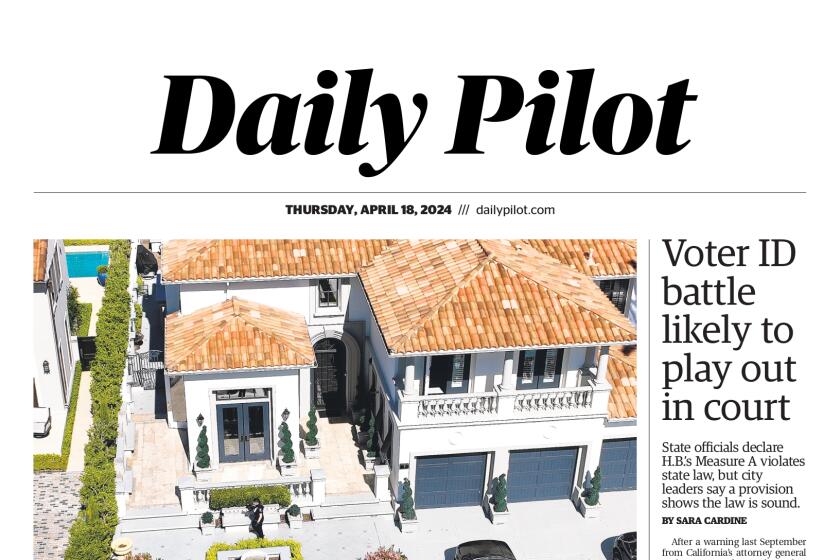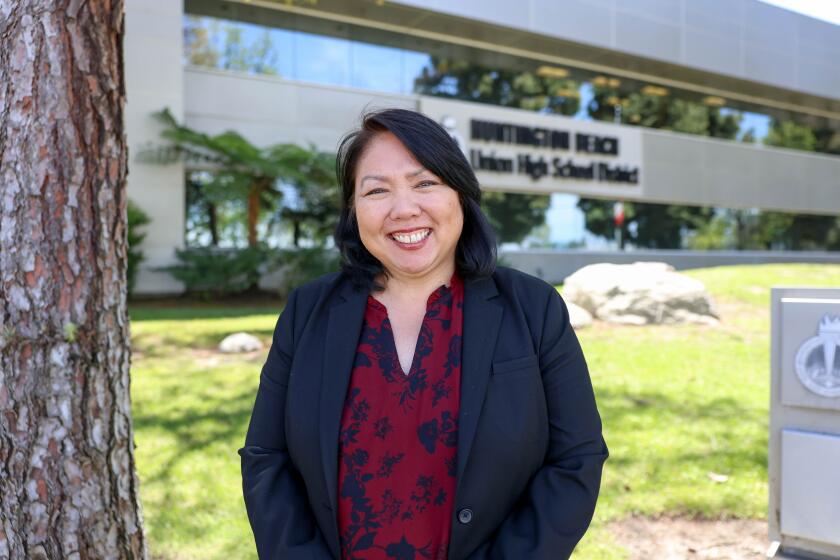‘Problem Home,’ Chapter 2: A history of challenging local government
Phillip Leland Richardson, who for years battled the city of Costa Mesa in a series of code enforcement disputes over his house, was born in Glendale on Aug. 3, 1947, the son of a Lockheed Martin aerospace engineer and a teacher.
His father, Ira Richardson, instilled in his children a black-and-white sense of right and wrong.
If you’re wrong, apologize and move on, Ira would say. And if you’re right, “make damn sure” you are, then stick to your guns.
“I’ve lived like that all my life,” Phillip Richardson said.
Richardson attended UCLA on a partial swimming scholarship. He had Olympic aspirations before being drafted into the Army in 1968 and sent to Vietnam. As a squad machine gunner, he endured months of jungle combat patrols, a period he recalled as “more like a bad dream than anything else.”
After returning stateside in 1969, Richardson met Julie Marie Sharratt, the daughter of Navy brass, during a party in Alexandria, Va.
Richardson has never forgotten Julie’s high-rise address back then: 4600 Duke St. After the party, Richardson often returned, knocking on Julie’s door. Through their chats, Richardson fell for her. After leaving the Army in 1970, he reconnected with Julie, who had taken a job in Orange County.
In 1973, the two were in the desert near Palmdale, playing golf, though neither liked it. Richardson abruptly declared: “This is boring. Let’s get married.”
It was more of an agreed-to statement than an on-your-knee proposal.
In February 1974, the two married at St. Michael & All Angels Episcopal Parish Church in Corona del Mar. Richardson wore a gold wedding ring of his own design. They honeymooned in Laguna Beach.
In 1976, the couple rented a three-bedroom, one-bathroom home at 276 E. 19th St. in Costa Mesa. He called the backyard a “wild prairie” of dried weeds. The newlyweds cleared it out.
Richardson concluded through research that it was a one-bedroom farmhouse built before 1906; two bedrooms and an indoor bathroom were added in the 1940s.
According to the Costa Mesa Historical Society, the house was built in 1945, possibly part of a property subdivided in the ’40s.
The 1,188-square-foot home was built with redwood, naturally resistant to termite infestation and good in marine climates. It featured a 288-square-foot “granny” unit and an 888-square-foot garage.
“There was nothing else on the street like it,” Richardson said.
In 1977, the Richardsons paid $55,000 for it.
Julie, who had grown up moving frequently in a military family, finally had a long-term home.
A dissenting voice on local committees
Three children followed — Melissa, James and then Michael. The family of five made the three-bedroom home work, even with a shared bathroom.
The Richardsons never planned to stay as long as they did. They figured the property’s value would peak at $250,000 (it would reach an estimated $1.2 million 40 years later).
Richardson held a variety of jobs: shoe salesman, computer consultant, construction company owner, real estate broker, boat and firearms appraiser, paralegal, Daily Pilot boating columnist.
He said his Richardson Investment Co. has owned or managed more than 150 properties. When collecting rent, he sometimes carried a shotgun in “areas where you needed a shotgun.”
Richardson, never one to bow to authority, found himself a dissenting voice when serving on local school committees. He recalled conversations about using money to pay for science kits, not a parade.
Richardson disagreed on a proposal to replace students’ desks. In his mind, unless the children got splinters while sitting in them, that money was better spent elsewhere.
He even once unsuccessfully suggested getting rid of the Newport Harbor High School math department, which he considered inadequate.
The ‘Gang of 5’ number-cruncher
In 1991, however, Richardson made a lasting mark on local history. He and four others, angered by school district budget problems, started poring through public records. He was the “math guy” in the “Gang of 5.”
The watchdog group became suspicious of Stephen Wagner, Newport-Mesa’s budget officer, who seemingly lived beyond his salary.
In December 1992, Wagner pleaded guilty to embezzling more than $3.5 million from Newport-Mesa, then believed to be the largest school embezzlement in state history.
Current Newport-Mesa trustee Dana Black, one of the Gang of 5, said Richardson’s number-crunching on his home computer proved “pivotal.”
Phillip and Julie Richardson “were volunteering and very active with kids, the community and our schools,” Black said. “Just really quality people. Wonderful.”
City Hall, however, would later form a very different view of the family and the way they maintained their home.
In Chapter 3, the fight between Richardson and City Hall over his Eastside home starts to ramp up.
Twitter: @BradleyZint
ALSO
‘Problem Home,’ Chapter 5: ‘The home can be brought back to its former glory’
All the latest on Orange County from Orange County.
Get our free TimesOC newsletter.
You may occasionally receive promotional content from the Daily Pilot.




